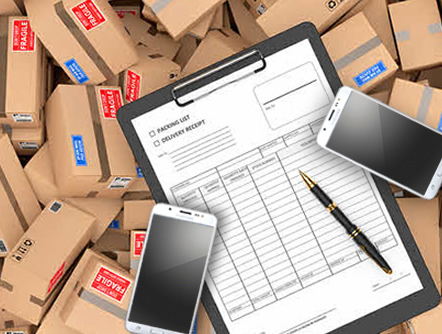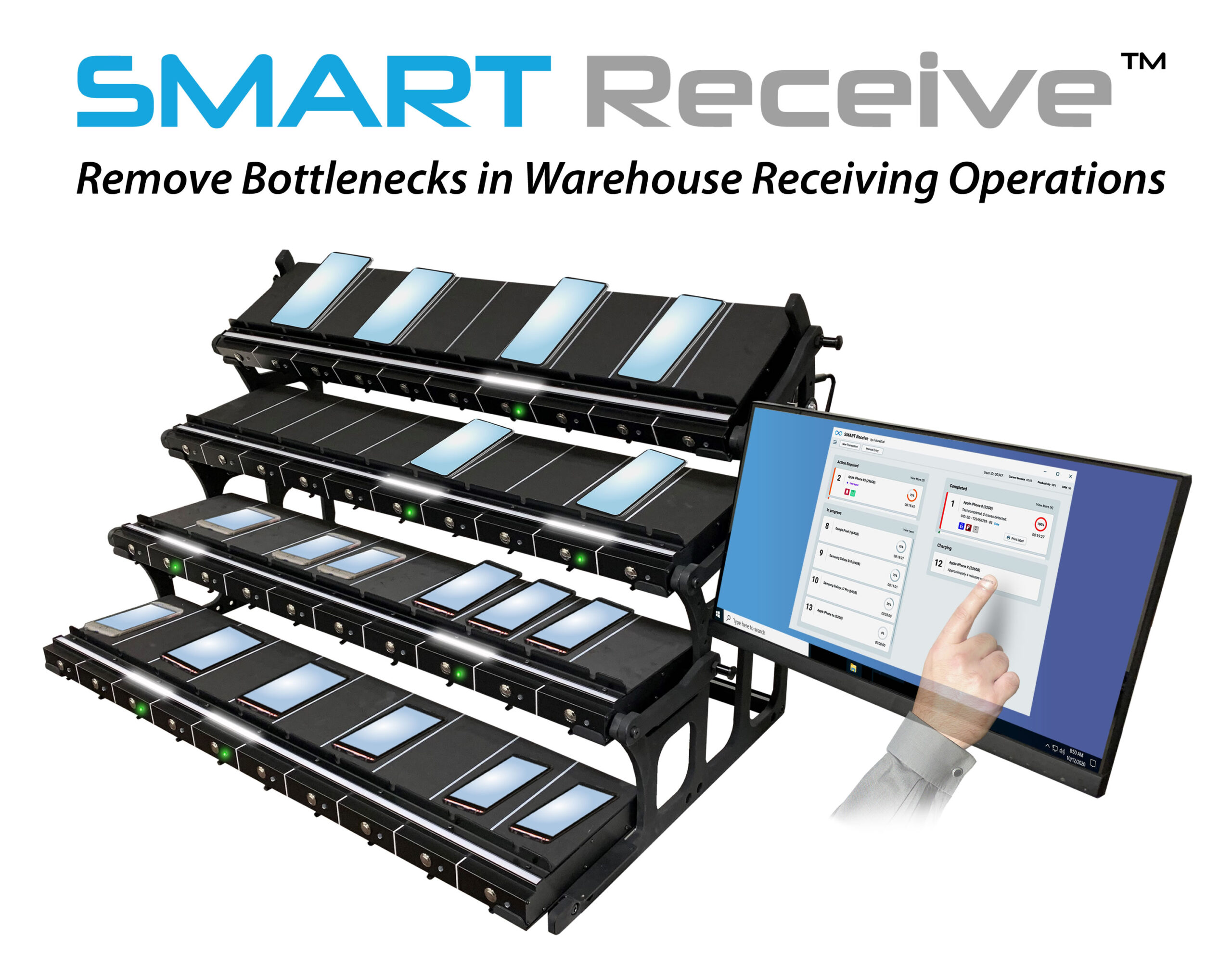The FutureDial Blog
( 2.05.2024 )
From Chaos to Efficiency: Transforming and Streamlining the Receiving Process in Mobile Device Refurbishing Warehouses and Processing Centers

TAKEAWAY: As thousands of preowned mobile phones get drop-shipped by the pallet at refurbishment business warehouses or processing centers, the receiving process is a critical step in the refurbishment journey. However, refurbishing warehouses and processing centers often face challenges at this crucial touchpoint, impacting overall efficiency and customer satisfaction.
In this blog article, we delve into the issues that we have observed during device receiving operations at these businesses, and we explore solutions to ensure accuracy and to streamline operations, which help set the stage for a successful refurbishment process.
Mastering Precision and Efficiency in the Heart of Device Reception
 At the heart of mobile phone refurbishment lies the crucial phase of device reception, a pivotal juncture that dictates the trajectory of the entire production line. Effectively tackling identified challenges and incorporating intelligent solutions empowers refurbishment warehouses and processing centers to elevate levels of precision, efficiency, and customer contentment. Strategic investments in automated technologies, proactive readiness for unforeseen scenarios, and achieving a harmonious equilibrium between speed and accuracy collectively lay the foundation for a prosperous and streamlined refurbishment expedition. Mastering the intricacies of the device receiving process not only optimizes business operations but also ensures the delivery of top-tier refurbished devices, ultimately leading to heightened customer satisfaction.
At the heart of mobile phone refurbishment lies the crucial phase of device reception, a pivotal juncture that dictates the trajectory of the entire production line. Effectively tackling identified challenges and incorporating intelligent solutions empowers refurbishment warehouses and processing centers to elevate levels of precision, efficiency, and customer contentment. Strategic investments in automated technologies, proactive readiness for unforeseen scenarios, and achieving a harmonious equilibrium between speed and accuracy collectively lay the foundation for a prosperous and streamlined refurbishment expedition. Mastering the intricacies of the device receiving process not only optimizes business operations but also ensures the delivery of top-tier refurbished devices, ultimately leading to heightened customer satisfaction.
Expect the Unexpected: Tackling the Unknown in the Device Receiving Process
Mobile phone refurbishing centers have a real head-scratcher when it comes to getting their hands on devices – you never know what’s hiding in those boxes they receive at the workstations. Picture this: every day, they get these big shipments with all sorts of phone models, making it a bit of a tech surprise party when they crack open the packages. And let’s be honest, this unpredictability can mess with their flow, causing delays, hiccups, and and maybe even lead to some mix-ups if they don’t handle it right.
 To tackle this puzzle, refurbishing centers need to put on their thinking caps and be on top of their game. They have to set up some solid check-in routines and inspection rules and use fancy scanning and recognition gadgets to make sure they know exactly what they’re dealing with, when it comes to identifying and sorting out those devices. It’s like putting on a detective hat for handling each device – making sure everything gets sorted out smoothly and mistakes are kept to a minimum.
To tackle this puzzle, refurbishing centers need to put on their thinking caps and be on top of their game. They have to set up some solid check-in routines and inspection rules and use fancy scanning and recognition gadgets to make sure they know exactly what they’re dealing with, when it comes to identifying and sorting out those devices. It’s like putting on a detective hat for handling each device – making sure everything gets sorted out smoothly and mistakes are kept to a minimum.
Let’s explore how these measures can set the foundation for seamless processing.
1. Sorting Through the Phone Jungle ― Inventory Diversity and its Impact:
The refurbishment industry deals with a wide array of mobile phone models, brands, and conditions. When these gadgets roll in for the receiving process, it’s like a phone variety show, and the inventory diversity can be overwhelming. Without a proper system in place, refurbishing centers may struggle to handle this variety efficiently. That’s where having solid inspection rules becomes a real game-changer, as they need a plan to tackle the phone chaos and keep things running smooth.
2. Getting Things in Check ― Implementing Robust Inspection Protocols:
To ensure a smooth device receiving process, refurbishing centers need well-defined inspection protocols that encompass various aspects of device identification and assessment. These protocols should include clear rules for checking out the devices that cover everything – what kind of phone it is, who made it, how beat up it is, and any special things they need to know for fixing it up. With a standardized step-by-step system in place, businesses can create consistency in the receiving process, making sure that every phone gets the same treatment, no matter what kind it is. It’s like having a playbook to make sure everything gets sorted out just right.
3. No More Oopsies ― Smart Sorting at Warp Speed with High-Tech Scanning Magic:
Trying to eyeball every single gadget takes forever, and let’s be real, mistakes happen. But these refurbishing centers can overcome this challenge by investing in sophisticated scanning and recognition technologies. Barcode scanners and optical character recognition (OCR) systems can zoom-in to swiftly capture essential device information and automatically input it into the refurbishment database. This reduces the risk of human errors and and the data entry hustle gets a major speed boost. It’s like getting a robot assistant to do the heavy lifting – quick and mistake-free.
4. Getting Smart with Pictures ― Utilizing Computer Vision for Condition Assessment:
Accurate condition assessment is crucial for determining the appropriate refurbishment path for each device. Computer vision technology, powered by artificial intelligence, can be employed to inspect devices for physical damages and defects. The smart part? The computer brain compares what it sees to a checklist of predefined criteria, giving an unbiased, objective, honest assessment. It’s like having a robot eye that scans devices for bumps, bruises, and any other issues. That means these processing centers can divvy up their resources in the smartest way possible, making sure everything gets the attention it needs.
5. Getting Quick and Organized ― Real-Time Data and Sorting:
So, after scanning and sizing up these gadgets, having the info right then and there is key. Refurbishing centers should employ integrated software systems that are all linked up, providing instant access to device information, condition reports, and processing requirements. Having this info in real-time means the crew can make fast decisions and get those gadgets sorted promptly and ensures that devices are sorted efficiently into the appropriate refurbishment queues. It’s like having a speedy playbook to keep everything running smooth and quick.
6. Fast-Tracking the Good Stuff ― Prioritizing the High-Value Devices:
With efficient inspection protocols and automated sorting, refurbishing centers can prioritize high-value devices for expedited processing. These are the top-of-the-line device models, such as flagship models or those limited editions – the real high-value gems. They’re the ones that need a bit of extra love and a speedy fix to meet the demand out there. By spotting and putting these top-tier devices at the front of the line, they give them special attention and swift refurbishment to meet market demands, capitalizing on their value and optimizing revenue potential.
Refurbishing preowned phones for profitable resale is no light task, especially when you don’t know what’s in the box. Tackling the unknown in the device receiving process is a vital step towards efficient mobile phone refurbishment. The smart businesses got it right, by implementing robust inspection protocols, leveraging sophisticated scanning and recognition technologies, and utilizing computer vision for condition assessment. Real-time info and quick sorting make the process a breeze, letting them jump on the good stuff pronto. It’s a game-changer for top-notch refurbishing, delivering quality gadgets to happy customers.

Accuracy is Key: Avoiding Billing Errors
So, when it comes to fixing up phones, it’s not just about the gadgets – accurate device receipt to get it right, from the get-go, is a big deal. Why? Because it is not just about the refurbishing process; it’s about getting the billing spot-on for customers. Mishandling or misplacing devices during the receipt process can lead to discrepancies later in customer bills, causing frustration and eroding trust. That’s why these operations need solid measures to make sure every gadget is accounted for from start to finish. Let’s explore how these moves keep the bills accurate and the customers happy.
1. The Impact of Receipt Accuracy on Customer Billing:
Device receipt accuracy has a direct and profound effect on customer billing. When a business (such as a wireless carrier, phone trade-in provider, or phone resseller) subcontracts with a third-party refurbishing operation for processing incoming devices for refurbishment, they expect a fair and accurate assessment from the refurbishing operation regarding the condition and value of all the devices being drop-shipped for refurbishing. They’re shipping over a bunch of devices for a spruce-up, and they want the refurbishing crew to give a fair and accurate take on each one’s condition and value. Any errors or mishandling during the receipt process can lead to incorrect billing, resulting in overcharges or undercharges for the contracting business. Such billing discrepancies can lead to frustration and a loss of trust in the refurbishing company. Getting the receipt game right is the key to keeping the billing on the money.
2. Prioritizing Accuracy at Every Step:
To ensure billing accuracy, refurbishing centers must prioritize accuracy at every step of the device receipt process. This starts with implementing well-defined inspection protocols and utilizing accurate scanning and recognition technologies to identify and categorize each device correctly. Barcode scanning, OCR systems, and computer vision technology can streamline the process, cutting down on the chances of human blunders and ensuring the right data is recorded for each device.
3. Rigorous Tracking Systems:
To maintain accountability throughout the refurbishment journey, refurbishing centers must establish rigorous tracking systems. Each device should be assigned a unique identifier, and its progress should be continuously monitored and updated in the refurbishment database. This level of meticulous tracking ensures that no device goes MIA, gets lost in the shuffle, or is overlooked during the processing stages.
4. Automated Data Recording:
Automation plays a crucial role in maintaining accuracy and consistency in data recording. Doing it all by hand is just asking for trouble – those little slip-ups can turn into big billing headaches. Let the machines take over with barcode scanners and computer vision for data recording. That way, you cut down on the risk of inaccuracies and you can streamline the data entry process, ensuring accurate and reliable information for each device.
5. Quality Control Checks:
Quality control checks at different stages of the refurbishment process are instrumental in maintaining billing accuracy. Regular audits and inspections verify that devices are progressing through the refurbishment workflow correctly and that their condition assessments align with the recorded data. Any discrepancies are promptly addressed, ensuring that the final billing aligns with the actual state of the refurbished device.
Preparing for Non-Happy Paths: Ensuring Smooth Device Receipt despite Unexpected Challenges
In any process, unexpected challenges may arise. The device receiving process is no exception. Non-happy paths, such as damaged shipments, incomplete packages, or other unforeseen issues, can throw a wrench into the refurbishment workflow if not handled promptly and effectively. To keep things running tight and ensure a hassle-free, smooth refurbishment journey, refurbishing centers need to lay down some solid protocols and solutions to tackle these curveball contingencies. By expecting the unexpected and having well-defined procedures in place, they can swiftly tackle problems head-on and keep the disruptions to a minimum. Let’s explore how to prepare for the unexpected twists or non-happy paths in the device receiving process.

Refurbishing centers kick off their device receiving process by conducting a thorough risk assessment, identifying potential issues like damaged devices or incomplete shipments. Armed with this knowledge, they develop solid contingency plans to effectively handle any situation that might arise.
Once the risks are clear, refurbishing centers establish precise protocols for dealing with non-happy paths. Immediate segregation and documentation for insurance claims address damaged devices, while communication with customers resolves issues with incomplete shipments. These protocols include specific instructions and assigned personnel for a swift and coordinated response. Ensuring staff is well-prepared is crucial for success, with training sessions teaching them to spot potential issues, document accurately, and take swift action. Regular refresher training keeps the team agile in adapting to unexpected challenges.
Collaboration with shipping partners is key, addressing transportation-related issues that often contribute to non-happy paths. Open communication helps prevent disruptions and ensures a smoother resolution process. Technology, in the form of barcode scanning and tracking systems, adds transparency to the receiving process, allowing real-time visibility and facilitating prompt identification and resolution of issues. To stay effective and agile over time, refurbishing centers regularly review protocols and solutions through post-mortem analyses, feedback, and proactive identification of enhancements.
Balancing Speed and Accuracy: Navigating Time Limits in the Device Receipt Process
Time is ticking in the refurbishing world, where hitting tight deadlines — usually 24 to 48 hours from dock delivery — is a real hustle. The rush to meet these time limits can sometimes throw a wrench in the works, risking slip-ups or quick fixes that mess with accuracy and quality. To keep the device receiving game on point without sacrificing precision, refurbishing centers can pull off some savvy moves. Tapping into automation tech and fine-tuning workflows helps them dance through those time limits with style, making sure their operations stay top-notch.
1. The Impact of Time Limits on the Receipt Process: Time limits in the device receipt process create a sense of urgency for refurbishing centers to hustle and promptly process and inspect those incoming devices. Hitting those deadlines is a must for keeping the whole operation smooth, but here’s the catch – speed can’t come at the cost of accuracy. Rushing through the initial receipt gig might seem like a quick win, but let’s be real – mess up there, and it’s like knocking over the first domino. The whole refurbishment journey gets thrown off, causing delays and leaving customers less than thrilled.
2. Adopting Automation Technologies: Let’s talk tech! Automation is the real game-changer when it comes to smoothing out the device receipt process and cranking up efficiency. Think barcode scanning systems swooping in to speed up device ID, ditching the manual data hassle and cutting down on human oopsies. With automated data entry in the mix, crucial info gets logged in real-time, making device tracking a breeze and waving goodbye to pesky delays.
Now, enter the star of the show: Machine Learning. These smart algorithms step up the game in assessing device condition during receipt. By crunching historical data and comparing it with the new device deets, machine learning models predict conditions with serious accuracy. Say goodbye to lengthy manual assessments while keeping that accuracy level sky-high. It’s like tech magic making the whole process faster, smoother, and spot-on.
3. Implementing Optimized Workflows for Speed and Precision: Refurbishing centers can enhance speed and accuracy by optimizing their workflows. Carefully designed and well-defined procedures ensure that each step of the receipt process is executed with precision, reducing the likelihood of errors and rework. By streamlining the sequence of activities and removing redundant steps, refurbishing centers can hit that sweet spot of getting things done fast without sacrificing quality. It’s all about finding that sweet balance.
4. Teamwork for the Win ― Cross-Training Staff for Versatility: To keep things flexible and on point with those tight time limits, refurbishing centers can mix things up by cross-training their crew in various receipt process tasks. Cross-trained employees can cover for each other when necessary, jumping in on different tasks when needed, keeping the flow going strong and avoiding any slowdowns or bottlenecks. This approach ensures that no single staff member becomes a roadblock or bottleneck in the receipt process, enabling a more efficient and agile operation, making the whole operation smoother and way more adaptable.
5. Boosting Efficiency through Cross-Training and Feedback: In the race against tight time limits, refurbishing centers are switching things up by cross-training their crew in various receipt process tasks. This dynamic approach ensures that team members can seamlessly cover for each other, preventing slowdowns or bottlenecks and keeping the workflow agile and efficient. No one person becomes a roadblock, and the entire operation becomes smoother and more adaptable.
But that’s not all. Refurbishing centers are all about continuous improvement. Beyond flexibility, they foster a culture of ongoing refinement. Seeking feedback from the staff and diving into data from the receipt process, they regularly sit down for review sessions and post-mortem analyses. This proactive approach helps them spot areas for enhancement and refine the receipt process continually. By incorporating employee suggestions and lessons learned, they’re on a constant journey towards optimization and increased efficiency. It’s a winning combo of adaptability and a commitment to getting better every day.
 From Challenges to Triumphs: The Strategic Impact of Streamlined Device Receiving
From Challenges to Triumphs: The Strategic Impact of Streamlined Device Receiving
When it comes to fixing up those mobile phones, the first step, aka the device receiving process, is a big deal. It’s like the captain of the refurbishment ship, steering the whole production journey. By addressing the observed challenges, tackling the challenges head-on and implementing smart solutions, mobile device refurbishing warehouses and processing centers can enhance accuracy, efficiency, and customer satisfaction.
Now, picture this: throwing in some tech magic, prepping for unexpected bumps in the road, and finding that sweet spot between speed and accuracy ― THAT is the recipe for a refurbishment journey that’s a total success. Get that device receiving process down pat, and businesses can fine-tune their game. The end goal? Dishing out top-notch, good-as-new phones to satisfied customers. Talk about a win-win!
 Your Key to Elevating and Streamlining Your Receiving Operations
Your Key to Elevating and Streamlining Your Receiving Operations
Top-tier players in the reverse logistics mobile supply chain, including mobile phone recyclers, tier-1 wireless carriers, refurbishers, third-party logistics providers, trade-in specialists, MNOs, MVNOs, phone resellers, and more, are choosing FutureDial for seamless integration of automation solutions to supercharge various touchpoints in their device processing operations.
FutureDial’s cutting-edge SMART Receive™ solution is the key to elevating the efficiency and profitability of your device receiving operations. Unleash the full potential of your mobile device receiving workflow by connecting with FutureDial today at sales@futuredial.com.
© 2024 FutureDial Incorporated. All Rights Reserved.

